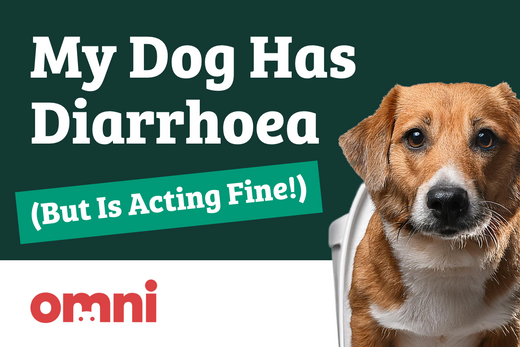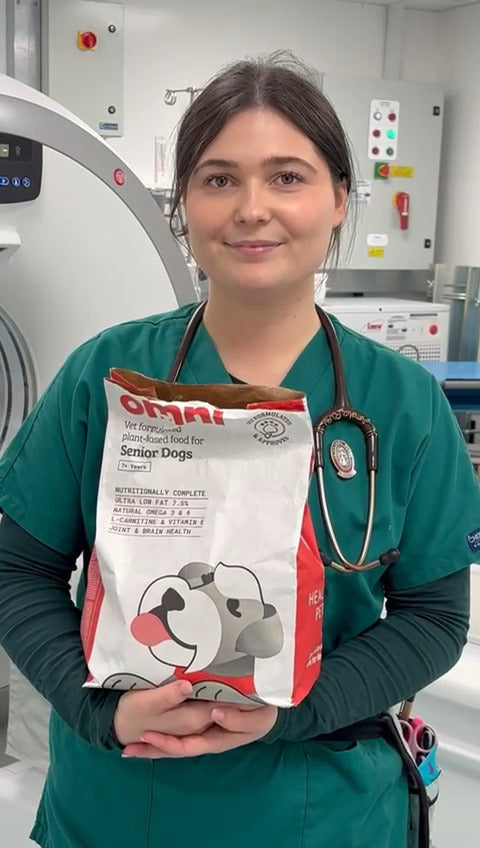My Dog Has Diarrhoea (But Is Acting Fine)

My Dog Has Diarrhoea, but is Acting Fine! Why?
Molly from Hertfordshire recently asked our vets this very question: “Why does my dog have diarrhoea, but is acting like everything’s fine?”
By the time she came to us, her Golden Retriever, Sammy, had been suffering with diarrhoea for around a week already, and nothing she had tried seemed to improve the situation. What’s more, Sammy didn’t seem to mind: she continued as if everything was normal!
Diarrhoea and loose stools in dogs are one of the most common complaints that owners come to vets with, so we thought it high time to deal with this problem in our Ask A Vet series.
If you’ve got a problem you’d like to be included in Omni’s Ask a Vet series online, just drop us an email to woof@omni.pet.
Our Chief Veterinarian, Dr Guy MRCVS had this to say:
There are many reasons why dogs can suffer from diarrhoea despite ‘acting normal’ outwardly.
- Eating something weird. Dogs off the lead can find all sorts of nasties in the undergrowth!
- Dietary allergies or sensitivities. Dogs can develop allergies at any stage in their lives, even if they never suffered with allergies as a pup.
- Potential pancreatitis. Read more below to find out how to spot pancreatitis.
- Tummy bugs that can be caused by bacteria, viruses or parasites
- Other abdominal diseases
Reasons Why Dogs Could Have Diarrhoea, But Act Normal
It Could Be a Sign of Having Eating Something Weird
Dogs off the lead can find, sniff and eat all sorts of undesirable nasties in the undergrowth of your local walking spots. Never underestimate your dog’s ability to find something disgusting lurking around the next corner!
As a result of this uncanny ability, dogs can frequently suffer digestive distress or pick up stomach bugs from their walks.
If this is the case, you’ll want to keep an eye out for a few other behaviours, too.
- Vomiting. If it’s just one occasion of vomiting but they are fine and well in themselves, then it’s likely nothing to worry about. But if they are persistently vomiting or weak, you should seek veterinary advice.
- Straining. Straining whilst defecating can sometimes lead your dog to suffer secondary colitis. You may notice fresh bright red blood and mucous. If there is a small amount of blood, it’s usually nothing to worry too much about, but it’s always worth asking your vet’s opinion, just to be sure.
- Diarrhoea that persists or is accompanied by lethargy and lack of appetite.
Usually, these sorts of symptoms pass naturally within a few days. If they persist or get worse, then talk to your vet and see if they can prescribe any medication to help with recovery. Ensure your dog is comfortable, drinking plenty, and not too anxious.
How to Help Your Dog Through Diarrhoea
If your dog matches some or all of the symptoms above, our vet team recommend:
- Hydration. Ensure that your dog has plenty to drink, as this can help flush out their system and also replaces the water lost through diarrhoea. You can offer an electrolyte solution (for dogs) if you are worrying that your dog has lost too much fluid already, failing this some low salt soup broth could help.
- Probiotics. Consider giving your dog a probiotic supplement to restore and replenish their gut microbiome.
- A stable diet. Changing their diet too much or using novel ingredients can exacerbate the problem. Make sure you keep their diet as regular and predictable as possible. We also advise to avoid common allergens in their diet, as in the next section.
- Fasting. Sometimes it is best to let the digestive system empty before trying to give them more food. Your dog may naturally reject food if they are suffering from bouts of diarrhoea anyway. Consider removing food for 12-24 hours, whilst ensuring they have plenty of water, before starting to feed them again.
- Small meals little and often. Its better to feed a tablespoon of food every hour than a large meal, the latter could overwhelm a sensitive tummy and cause vomiting.
Diarrhoea Could Indicate Allergies or Sensitivities, Too
There’s a possibility that it could be a symptom of allergies or sensitivities to particular food substances in their diet. You should know that, even if you think your dog does not have any allergies (which may well have been the case!), dogs, like humans, can develop allergies or sensitivities to particular ingredients at any time in their life.
In this case, you’re going to want to look out for:
- Itchy or inflamed skin. This is a common sign of allergies in both humans and dogs. You can often treat this via supplementation.
- Sneezing or coughing.
- Chronic ear infections or itching behind the ear. Ears are a very sensitive part of dogs and often flare up from allergies. Again, this can be treated via supplementation.
- Excessive licking or chewing of paws. This goes hand-in-hand (or, rather, paw-in-paw!) with the itchy and inflamed skin and/or ear infections.
- Vomiting as well as relatively consistent diarrhoea.
How to Address Allergies
In this case, Omni’s vets recommend:
- A hypoallergenic diet, of course. You will want to remove as many allergens from your dog’s diet as soon as possible. The commonest allergens for dogs are animal proteins, which is why we recommend a novel protein diet, containing protein from plants, algae, and yeast instead. Our vets recommend Omni Sensitivity for dogs requiring hypoallergenic food.
- An allergy test for dogs. Talk to your veterinarian about this, as they may be able to provide this in the clinic. It’s always helpful to allay any doubts by finding out exactly what it is your dog is allergic to!
Diarrhoea Can Also Indicate Pancreatitis
This sounds like (and is!) a more serious condition, but we don’t want you to worry - many dogs with pancreatitis will completely recover and go on to live a normal, healthy life!
It’s important to maintain a certain level-headedness when considering your dog’s health, as they’re counting on you to make positive, informed decisions about their wellbeing.
Pancreatitis is caused by the inflammation of the pancreas, often due to fatty foods such as cheese, which are far too rich for dogs to digest properly. (While dogs do often love cheese, they are incapable of digesting both the lactose and the fats contained within!)
With that said, the other signs of pancreatitis, besides diarrhoea, are:
- Vomiting, especially if repeated.
- Stretching or bowing into a prayer-like position. This ‘yoga pose’ (it’s often compared to the downward-dog position!) is not just to keep your pooch fit and limber - it relieves pressure on their pancreas.
How to Address Allergies
In the case of a dog suffering pancreatitis, Omni’s vets recommend:
- A low-fat diet. All of Omni’s diets are low fat, so choose whichever life stage is applicable for your dog.
- Visiting the vet. Vets can prescribe anti-nausea medication, pain medication, gastric acid suppression medication, and potentially subcutaneous fluid administration to help them to rehydrate after fluid loss from diarrhoea and vomiting.
- X-rays, ultrasounds or blood tests. Again, take your dog to the vets for these: X-rays can be used to check for any other potential causes like intestinal blockage, while blood work can find elevated levels of pancreatic enzymes caused by the inflammation. The ultrasound, however, is one of the most accurate ways of diagnosing pancreatitis.
If you are unsure, you can always speak with us also.
Speak with a vet if…
If the diarrhoea has persisted for more than 3-5 days, or if there is lots of blood in your dog’s faeces, or small amounts of blood on more than one occasion. If they have continued poor appetite and generalised lethargy, you should also seek urgent veterinary advice.
Take your dog to your vets if…
Your dog has lost large volumes of blood through diarrhoea, or if they have not eaten in more than 24 hours.
Thoughts from Dr Guy MRCVS
As dog lovers and guardians, it’s natural to worry about our furry friends, especially when they display abnormal symptoms that can’t be easily explained. That’s why, when I founded Omni, I knew that I wanted to keep vet consultation free and accessible at the heart of the business.
If you’re understandably worried about your dog, but you don’t think you need to take them to the vets urgently, I highly recommend getting some friendly, professional advice from one of our team.
Got a question for the Ask A Vet team?
Submit your question below, or email it in to woof@omni.pet. We’ll get back to you as soon as we can, and, if suitable, post the response here to help others, too!
Disclaimer: Whilst the advice given here is based on medical experience from our experts, and scenarios we do encounter during our career - we do not give tailored or specific advice for individual pets - please seek assistance from your in person vet as a first point of call with any issues your pet is having which are a cause for concern as soon as possible.







 85 Great Portland Street, 1st Floor, London, W1W 7LT United Kingdom
85 Great Portland Street, 1st Floor, London, W1W 7LT United Kingdom